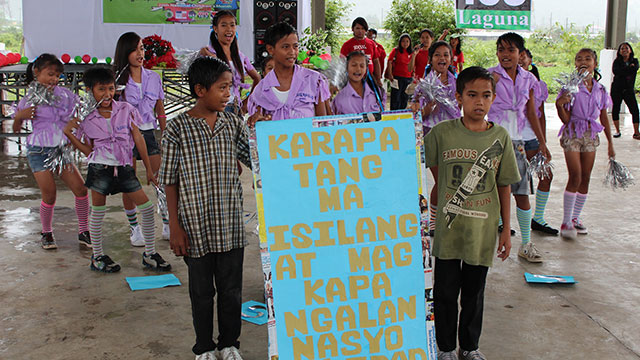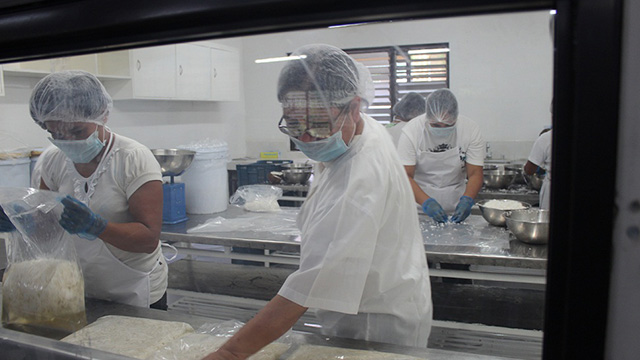SUMMARY
This is AI generated summarization, which may have errors. For context, always refer to the full article.

MANILA, Philippines – The ABS-CBN Foundation took exception to allegations that its Bayan ni Juan relocation project in Caluan, Laguna, is beset with various problems.
In a statement sent to Rappler, the Bayan ni Juan team (BNJ) decried the “sweeping generalizations” in the article “Failed relocation in Bayan ni Juan,” which was published on Rappler on November 23.
Below is BNJ’s statement in full:
How does one measure the success or failure of a relocation project ? George Moya’s sweeping generalizations in his article “Failed Relocation in BayaniJuan” reflect a very shallow understanding of developmental work and obviously his lack of research and factual information. We would like to take up issues raised point by point.
1. Mr Moya wrote: “Despite given a place to live, the settlers have no place to make a living.”
Residents who choose to find work at BNJ have several options within the site. At present, BNJ has two locators – a greeting card company and a food manufacturing company. Both locators employ BNJ residents and even those from barangays beyond the relocation site. The greeting card company exports handmade cards to Europe and allows workers to earn an average of P500-1,000 per week depending on output. The food manufacturer, on the other hand, processes local crops which includes macapuno, ube, banana and coconuts. Because of the high demand for ube, residents have likewise started to engage in contract growing.
There are homegrown industries in BNJ such as duck farming. “Itikan ni Inay” supplies salted eggs to commercial bakeries and market stalls. There are many farmers that grow an assortment of vegetables, herbs and mushrooms. Together with the BNJ Producers Association, they are able to sell their produce to neighboring towns and provinces and even to weekend markets in upscale malls in as far as Makati.
Vetiver is cultivated to supply slope protection grasses used in the landscaping of the esteros of Pasig. Contract growers earn an average of P6,000 – P25,000 every 3 months.
BNJ also employs residents at the Materials Recovery Facility to produce concrete pavers from shredded plastic from the site. The pavers are used for construction projects of government agencies in Manila.

To pump up economic activity in BNJ, ADB has provided livelihood assistance and social entrepreneurship funds of US$310,000 (P13.33 M) which BNJ has been releasing to qualified applicants. Individual assistance is up to P15,000 while group assistance is up to P100,000. Residents are able to fund home based businesses like tailor shops, sari- sari stores and eateries among others.
2. Mr Moya wrote: “Settlers have been moved to a dangerous neighborhood, with a noted increase in criminality.”
Perhaps Mr. Moya should be more careful and sensitive when branding a community as “a dangerous neighborhood.” It is blatantly offensive and hurtful. BNJ’s residents, like the rest of us, are peace-loving people and like everyone else, residents have their share of disagreements between family members and neighbors. We have yet to see a community of thousands where there is nothing but peace and quiet.
To maintain peace and order in the site, BNJ has entered into a memorandum of agreement with the Armed Forces of the Philippines. Fifteen Bantay Bayan personnel are deployed in each of the two barangays. Local volunteer marshals have been mobilized. A Community Police Action Center operates within the relocation site.
3. Mr Moya wrote: “Social services are lacking… basic necessities such as power and water are still a problem.”
BNJ is 107-hectare property. Prior to the involvement of BNJ in 2009, all there was were dilapidated houses, vacant lots and tall grasses(talahib). In 3 years, through the support of agencies and partners, BNJ has invested more than P50-million for the electrification of the site alone. A grant from the Asian Development Bank (ADB) provided P10 million to equip homes for electrification and for connection fees of communal facilities, and P40 million from the Department of Energy for Meralco to electrify the resettlement site. To date, the site has electricity in the livelihood center, the training center, the community center, the clinic and 921 housing units. A total of 48 solar street lights have been installed. Meralco is set to electrify site 2 and site 3.
Civil works for water services have been completed in 2012 and NHA has installed piped water in site 3 since the first quarter of the year. Communal water systems will be built from grants from the Asian Development Bank at site 1 and another one at site 2, with the help from Habitat for Humanity and Laguna Water.
Beyond power and water, BNJ provides health services to all its residents. The BNJ Clinic is staffed with 2 doctors, 1 midwife and 2 nurses. Daily, it treats and provides free medicines for an average of 40 patients. There is also a 1,000-day program for maternal and child health which, due to its astounding success, is now on its second cycle. Three babies have already been born in the clinic, using facilities and equipment donated by the Australian government.
There are two full grade elementary schools inside BNJ – Sto. Tomas Annex and OML Dayap Elementary School – with former estero kids now exemplary students winning regional awards. There are also 2 Day Care Centers. An Alternative Learning System is also available to OSYs as well as sports and recreation programs like running and football. A variety of programs such as feeding, scholarships, child abuse reporting and intervention, education in children’s rights/abuse detection, counseling are provided by Bantay Bata, which has extended its services not only to BNJ but also to the entire Southern Tagalog region.
What Mr. Moya has done was paint a very bleak picture of a community no different from where most of us exist. To expect utopia of any relocation site is not only unfair but unrealistic. BNJ is a work in progress and it will continue to thrive for as long as the spirit of bayanihan lives among us – ordinary people, big business corporations, NGOs, volunteers and government agencies who make it possible for BNJ to survive. What BNJ represents is the coming together of people for the sake of those who have lived through the worst of circumstances. Those who have lived in squalor along the banks of a dead river or those whose homes were washed away by Ondoy.
BNJ is not a community of prostitutes, of criminals, of the idle and jobless – but a beautiful community of those who have learned once again how to hope, to dream and realize those dreams. It is a community where one can find if he chooses to, a new sense of purpose, pride and belonging, in a place one can truly call home. That in itself is success. – Rappler.com
Add a comment
How does this make you feel?
There are no comments yet. Add your comment to start the conversation.